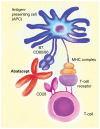Drug adherence to biologic DMARDS with a special emphasis on the benefits of subcutaneous abatacept
- PMID: 22936845
- PMCID: PMC3429155
- DOI: 10.2147/PPA.S23786
Drug adherence to biologic DMARDS with a special emphasis on the benefits of subcutaneous abatacept
Abstract
Major advances in drug development have led to the introduction of biologic disease- modifying drugs for the treatment of rheumatoid arthritis, which has resulted in unprecedented improvement in outcomes for many patients. These agents have been found to be effective in reducing clinical signs and symptoms, improving radiological damage, quality of life, and functionality, and have also been found to have an acceptable safety profile. Despite this, drug adherence is unknown, which has huge health care and health-economic implications. Local and national guidelines exist for the use of biologics; however, its varied use is widespread. Although this may in part reflect differences in prescribing behavior, patient preference plays a key role. In this review we will explore the factors that contribute to patient preference for, and adherence to, biologic therapy for rheumatoid arthritis with emphasis on the subcutaneous preparation of abatacept, a T-cell costimulatory molecule blocker. Overall, subcutaneous administration is preferred by patients and this may well improve drug adherence.
Keywords: abatacept; adherence; biologic DMARD; compliance; preference; rheumatoid arthritis; self-injectable; subcutaneous administration.
Figures


Similar articles
-
Biologics or tofacitinib for rheumatoid arthritis in incomplete responders to methotrexate or other traditional disease-modifying anti-rheumatic drugs: a systematic review and network meta-analysis.Cochrane Database Syst Rev. 2016 May 13;2016(5):CD012183. doi: 10.1002/14651858.CD012183. Cochrane Database Syst Rev. 2016. PMID: 27175934 Free PMC article. Review.
-
Biologics or tofacitinib for people with rheumatoid arthritis unsuccessfully treated with biologics: a systematic review and network meta-analysis.Cochrane Database Syst Rev. 2017 Mar 10;3(3):CD012591. doi: 10.1002/14651858.CD012591. Cochrane Database Syst Rev. 2017. PMID: 28282491 Free PMC article. Review.
-
Treatment persistence among patients with rheumatoid disease (RA, AS, PsA) treated with subcutaneous biologics in Germany.Rheumatol Int. 2016 Jan;36(1):143-53. doi: 10.1007/s00296-015-3348-4. Epub 2015 Aug 28. Rheumatol Int. 2016. PMID: 26314368
-
Biologic or tofacitinib monotherapy for rheumatoid arthritis in people with traditional disease-modifying anti-rheumatic drug (DMARD) failure: a Cochrane Systematic Review and network meta-analysis (NMA).Cochrane Database Syst Rev. 2016 Nov 17;11(11):CD012437. doi: 10.1002/14651858.CD012437. Cochrane Database Syst Rev. 2016. PMID: 27855242 Free PMC article. Review.
-
The clinical effectiveness and cost-effectiveness of abatacept, adalimumab, etanercept and tocilizumab for treating juvenile idiopathic arthritis: a systematic review and economic evaluation.Health Technol Assess. 2016 Apr;20(34):1-222. doi: 10.3310/hta20340. Health Technol Assess. 2016. PMID: 27135404 Free PMC article. Review.
Cited by
-
Predictive Factors for Rheumatoid Arthritis Flare After Switching From Intravenous to Subcutaneous Formulation of Tocilizumab in Real-World Practice.J Korean Med Sci. 2022 May 2;37(17):e138. doi: 10.3346/jkms.2022.37.e138. J Korean Med Sci. 2022. PMID: 35502504 Free PMC article.
-
A Nationwide Survey on Patient's versus Physician´s Evaluation of Biological Therapy in Rheumatoid Arthritis in Relation to Disease Activity and Route of Administration: The Be-Raise Study.PLoS One. 2016 Nov 28;11(11):e0166607. doi: 10.1371/journal.pone.0166607. eCollection 2016. PLoS One. 2016. PMID: 27893771 Free PMC article.
-
Certolizumab pegol: a review of its use in the management of rheumatoid arthritis.Drugs. 2013 Jan;73(1):75-97. doi: 10.1007/s40265-013-0009-3. Drugs. 2013. PMID: 23338540 Review.
-
First-line biologic therapy with tumor necrosis factor inhibitors for psoriatic arthritis: a prospective observational study.Sao Paulo Med J. 2022 Nov-Dec;140(6):787-797. doi: 10.1590/1516-3180.2021.0434.R1.22022022. Sao Paulo Med J. 2022. PMID: 36043662 Free PMC article.
-
Medication persistence for psoriatic arthritis in a Brazilian real-world setting.Future Sci OA. 2019 Jan 18;5(2):FSO369. doi: 10.4155/fsoa-2018-0101. eCollection 2019 Feb. Future Sci OA. 2019. PMID: 30820348 Free PMC article.
References
-
- Adherence to Long-Term Therapies: Evidence for Action. World Health Organization. Geneva: World Health Organization; 2003. [Accessed 19 June, 2012]. Available from: http://apps.who.int/medicinedocs/en/d/Js4883e/
-
- Ho PM, Rumsfeld JS, Masoudi FA, et al. Effect of medication non-adherence on hospitalization and mortality among patients with diabetes mellitus. Arch Intern Med. 2006;166:1836–1841. - PubMed
-
- Ho PM, Spertus JA, Masoudi FA, et al. Impact of medication therapy discontinuation on mortality after myocardial infarction. Arch Intern Med. 2006;166:1842–1847. - PubMed
-
- Sokol MC, McGuigan KA, Verbrugge RR, Epstein RS. Impact of medication adherence on hospitalization risk and healthcare cost. Med Care. 2005;43:521–530. - PubMed
LinkOut - more resources
Full Text Sources
Research Materials

